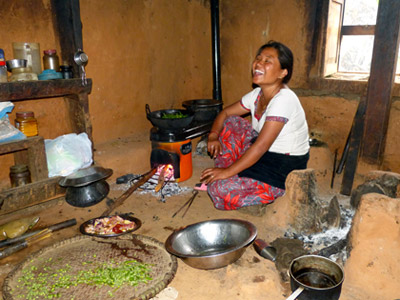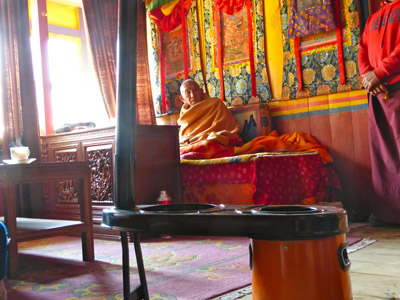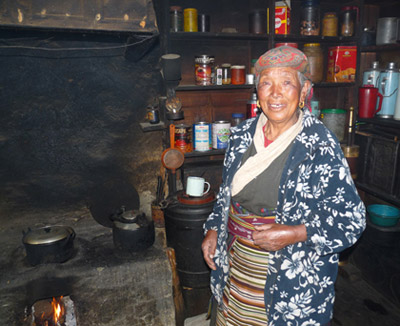The Himalayan Stove Project: Changing the World One Cookstove at a Time
The Himalayan Stove Project believes in conserving nature and in improving the health and lives of people. It is achieving that mission right now in the high Himalayas of Nepal, thus transforming the lives of individuals, families and communities – one clean cookstove at a time. The problems the Project are addressing and solving are obvious. Inefficient cookstoves in the fragile high Himalayan environment (and elsewhere) cause 1.) indoor air pollution and related health issues due to smoke inhalation, 2.) personal safety hazards to families and their children, 3.) deforestation, 4.) climate change and 5.) economic and other social issues. The Himalayan Stove Project is a U.S. public charity staffed totally by volunteers who pay all their own expenses, including travel to Nepal. In addition, a growing community of institutions, corporations and individuals supports its very pragmatic mission of making a difference now.
Indoor Air Pollution (IAP) is the planet’s 4th-largest public health threat after malaria, clean water and HIV-Aids. According to the World Health Organization (WHO), IAP results in the death of two million people every year. Three billion people – almost one-half of the world’s population – cook over open fires or with primitive, polluting, dangerous cook stoves. This is not a new issue in the 21st Century. People have been cooking this way forever and filling their caves, or homes, and lungs with smoke. They have also seen their infants horribly burned, crippled and disfigured as they stumble into open fires. In addition, such stoves strip the environment of massive amounts of “biomass” fuel needed to feed these open fires or their inefficient cooking “appliances.”
What if the cooking process were more efficient and safer, used less fuel and generated less smoke? And, what if that smoke was vented outside the dwelling rather than staining the roof beams with sticky black tar, which also coats the airways of the lungs? What would happen to the carbon-load on the environment if the cooking process used less fuel for the same cooking effect? The common sense answer is that it would make a difference, a positive difference.
An efficient, clean-burning stove would transform the life of one family and have a positive impact on the environment. One thousand stoves would transform the lives of 1,000 families – “one clean cookstove at a time” – and have a magnified positive impact on the environment. People would have improved health; small children would be less likely to fall into an open fire, and fewer trees would be sacrificed to cook the family’s meals. In addition, more time would be available for children to attend school, rather than foraging for diminishing fuel supplies, and families would have more time to live better, more constructive lives.

.
IAP and other harmful personal and environmental impacts caused by using primitive cooking “technologies” is a global issue. It is being addressed worldwide by the Global Alliance for Clean Cookstoves, an initiative launched September 2010 by the World Health Organization, United Nations Foundation, Clinton Initiative, Shell Foundation and dozens of governments and philanthropic organizations. The Global Alliance has a goal to put 100 million clean cookstoves into service by 2020, and actress Julia Roberts is their spokesperson. That is a lofty, ambitious goal and, when accomplished, will be a significant step in transforming the lives and health of the three billion people affected by primitive cookstoves. Expanded use of cleaner cookstoves globally will also be a helpful, short-term aid in slowing degradation of the climate.
National Aeronautics and Space Administration (NASA) scientists, in a study published in a January 2012 issue of Science, say that while carbon dioxide from fossil fuels like coal and oil remain a larger overall cause of global warming, reducing methane and soot may offer short-term solutions that could slow impacts of global warming. Some academics may argue that “better, more efficient” ways exist for addressing the climate change issue, and they may be right. But, the Himalayan Stove Project takes the pragmatic position of “let’s do something now!”
This kind of “can do” attitude helped George Basch, “chief cook” of the Himalayan Stove Project, forge a relationship with the Mayo Clinic, which was strengthened in 2012 when he and his team visited Nepal in April and May. There they met with the Mayo team while it was involved in a high-altitude physiology study of climbers at Mount Everest. As a result, Bruce Johnson, M.D., wrote the following to Basch in an October 2012 letter: “You can certainly put down that you have the support of Dr. Bruce Johnson and his Human Integrative Physiology Laboratory of the Mayo Clinic. I would be happy to support you any way I can. Also, you could suggest we are in the process of collaborating on a project related to respiratory health.”
This huge feather in the Project’s cap and its “work in progress” will provide important, supportive, scientific data. In the meantime, the Project’s “let’s do something now” attitude is already transforming the lives of 1,400 individuals and families.
The Himalayan Stove Project was sparked in 2009 on a trekking trip in Bhutan, where a Polar Researcher told Basch about “the” stove, and a light-bulb turned on just like in the cartoons. Basch had, on previous trips to the Himalayas, observed the basic problems. However, the “light-bulb” moment in Bhutan was the catalyst for identifying a multi-faceted solution to solving personal and environmental problems in the particularly fragile, remote and isolated high Himalayan environment where problems were acute and magnified by high altitudes and severe fuel shortage.
The project became active in early 2010, and the first pilot shipment of clean cookstoves was in the field in Nepal and Bhutan for testing and evaluation when the Global Alliance for Clean Cookstoves was officially launched on Sept. 21, 2010.

.
The Himalayan Stove Project has become an “implementing partner” of the Global Alliance. The “business model” of the Himalayan Stove Project is very straightforward, practical and pragmatic. The Project focuses on those things it can do exceptionally well while other important functions are left to better-qualified people or organizations. For example, the Project sourced the stove, interfaces with the manufacturer, designs and manages the supply chain, sets overall policy and oversees the entire program, and manages fundraising. Manufacturing is left to a qualified and experienced manufacturer – one with its own large operation not dependent on the Himalayan Stove Project to sustain its operation. Interface with local communities is handled by existing, established organizations, which have historic and continuing contact with “their” communities and that understand specific local needs and cultural nuances through years of experience.
The stove that was selected provides the same cooking effect as those historically used but with 80 percent less fuel and a proportionate reduction in noxious, harmful smoke. Envirofit manufactures it in Shanghai, China. When selected in 2010, the stove had already been field-proven with more than 200,000 in service. It is “bomb proof” with no service issues – a critical factor in one of the most remote regions on Earth with no UPS and FedEx. Envirofit is well financed and a leader in the global clean cookstove community. As of October 2012 more than 450,000 Envirofit stoves were in service throughout the world.
In Spring and early Summer 2011, after the Project’s 2010 pilot-test was evaluated, local Himalayan Partners – the people on the ground – identified requests for 4,000 stoves. As of October 2012, delivery and installation of the first 1,400 stoves was being completed and the lives of individuals, families and communities were being transformed, one clean cookstove at a time. What started as a simple vision in October 2009 has now, at the beginning of 2013, become a functioning program. In fact, further field evaluation during Spring and Summer 2012 revealed that the need and demand in Nepal is well beyond the fragile high Himalayan region, thus making “market demand” huge.
Basch and his team worked in Nepal during that time making personal contact with people using the stoves and setting up the complicated infrastructure and systems for getting the stoves from the Kathmandu warehouse to the final destination – the “last mile” (and more) is always on the back of a porter or yak. The most gratifying part of the entire program is witnessing the transformation that a new, clean-burning, smoke-free stove makes in people’s lives. The team has witnessed truly life-changing experiences. Words cannot convey the emotion, but the organization’s website and blog have videos, pictures and stories, which convey the experiences at http://himalayanstoveproject.org.
The value of relying on the experience and knowledge of the Himalayan Partners was proven immediately at the beginning of the project. The partners were very clear and forceful that giving stoves as a gift was a bad idea. They maintained that the recipients had to have an investment – a “buy-in” with the stove – so it would have “value” to them. In a country with average earnings of $20 per month (and these communities are below “average”), buy-in for a stove costing between $125 and $150 delivered is “challenging.” Therefore, the Project decided to let the partners handle buy-in specifics at the local level with the only requirement being that the money stay in each local community.
One buy-in has been for a cash amount of $10, which is significant to these impoverished people. Others range from going to the health clinic or day-care center to participating in community activities. Giving in-kind community service of some sort has also worked well. The most innovative and sustainable buy-in program was established in the remote community of Megere. A mothers’ group set up a micro-lending program in which each stove-recipient puts $7.50 into a loan fund that the mothers’ group administers. The money, when repaid, is recycled back into the system, thus helping the community grow through its own efforts. Another partner organization has been running a micro-lending program for four years on another project and has had a 98 percent repayment rate.
The project has caught the imagination of the Himalayan Climbing community and is supported by an “A” list of eminent mountaineers. Chris Bonington, Tom Hornbein, Doug Scott, Erik Weihenmayer and Jeff Evans serve on the Board of Advisors. Other supporters include Reinhold Messner, Conrad Anker, Dave Hahn, Carlos Buhler, Simone Moro, Phil Powers, Mark Richey Steve Swenson, Sandy Hill, Rebecca Stephens, Jimmy Chin, Charley Mace, Doug Beall and many others. Supporting organizations include, among others, the American Alpine Club, Outside Magazine, Rock & Ice, GlacierWorks, Eddie Bauer, Adidas, MSR, Cordura, Global Rescue and Kobold Expedition Watches.
Yvon Chouinard, Patagonia’s environmentalist founder, has for years, as a matter of core company policy, been assessing Patagonia an “Earth Tax” – 1 percent of gross sales – and devoting those funds to environmental causes. This has been institutionalized beyond Patagonia in a non-profit organization called “1% for the Planet” (1% FTP), which is a growing global movement of more than 1,000 companies that donates 1 percent of their sales to a network of more than 3,000 approved environmental organizations worldwide. The Himalayan Stove Project is an “approved environmental organization” of 1% FTP. When the project was inducted, the 1% FTP “Membership Marshall” said, “The Himalayan Stove Project exemplifies the direction I’d like to take our nonprofit membership in the future – increasing the emphasis on the importance of humanity in a holistic definition of sustainability.” The Project is understandably thrilled with the institutional endorsement as well as a personal contribution by Chouinard.

.
The project itself has minimal overhead, an all-volunteer staff who pays their own expenses, including travel to Nepal, and makes significant contributions to the local economy. The chimney system is fabricated in Nepal, and transportation and distribution costs are part of the project’s contribution.
In its short life-span (original concept in October 2009 with actual “work” undertaken in January 2010), the Project has come a long way. The original goal of 10,000 stoves in five years can be expanded to an almost infinite number. The population in the mountainous regions of Nepal is approximately five million and another 25 million people live in the rest of the country. More than 20 million are “rural” and faced with the same health hazards and deforestation issues as the Himalayan population.
The “only” thing needed is funding and perhaps more organizational support as the program grows. In addition to expanding opportunities in Nepal, inquiries have been dribbling in from the Himalayan Regions of India and Pakistan. (And the dribble is expanding to a trickle as word gets out.) The Himalayan Stove Project needs funding both to continue and to expand its mission of changing the world one clean cookstove at a time. For more information, go to http://himalayanstoveproject.org or contact Basch directly at george@himalayanstoveproject.org.




























